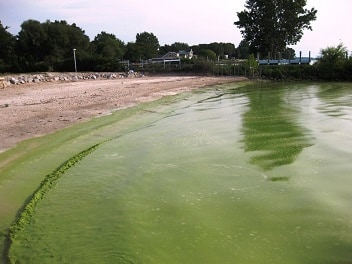COLUMBUS – One year after an algal bloom tainted drinking water in Toledo, a new report examines the ways climate change is threatening Lake Erie and other bodies of water.
According to the findings from the National Wildlife Federation, the Midwest has experienced dramatic changes in climate over the last decade, including a 37 percent increase in heavy rainfall events in the Great Lakes region.
Senior scientist Doug Inkley says more frequent rains are spawning harmful algal blooms.
“It washes off more of the nutrients from the agricultural lands and rural areas into the lake,” he said. “and that is what scientists believe is a major factor contributing to the return of algal blooms to western Lake Erie, where it is so shallow.”
A half million residents went without drinking water for three days because of the crisis. Besides drinking water, the report also outlines how warming temperatures are changing streams, rivers and oceans, and impacting wildlife and habitat.
A large algal bloom is being monitored near Toledo, but water supplies are safe. Lucas County Commissioner Pete Gerken said the community still is on guard after last year’s crisis.
“The initial reaction a year ago was widespread panic,” he said. “It was new to the psyche of the community because you didn’t know when it started and ended. There are people in this community that are still stocking private water that refuse to drink what used to be the best city tap water in the country.”
The report outlined strategies to confront climate change, including the Environmental Protection Agency’s recently finalized Clean Power Plan, which limits carbon pollution from power plants. Inkley said the plan is crucial to protecting wildlife and water around the nation.
“From the mountaintops to the oceans, it is affecting us everywhere,” he said. “That’s why it’s important that Ohio and other states implement the Clean Power Plan.”
He adds that the Environmental Protection Agency’s proposed Clean Water Rule will also help to protect at least 60 percent of streams and 20 million acres of wetlands nationwide.
The report is online at nwf.org.






